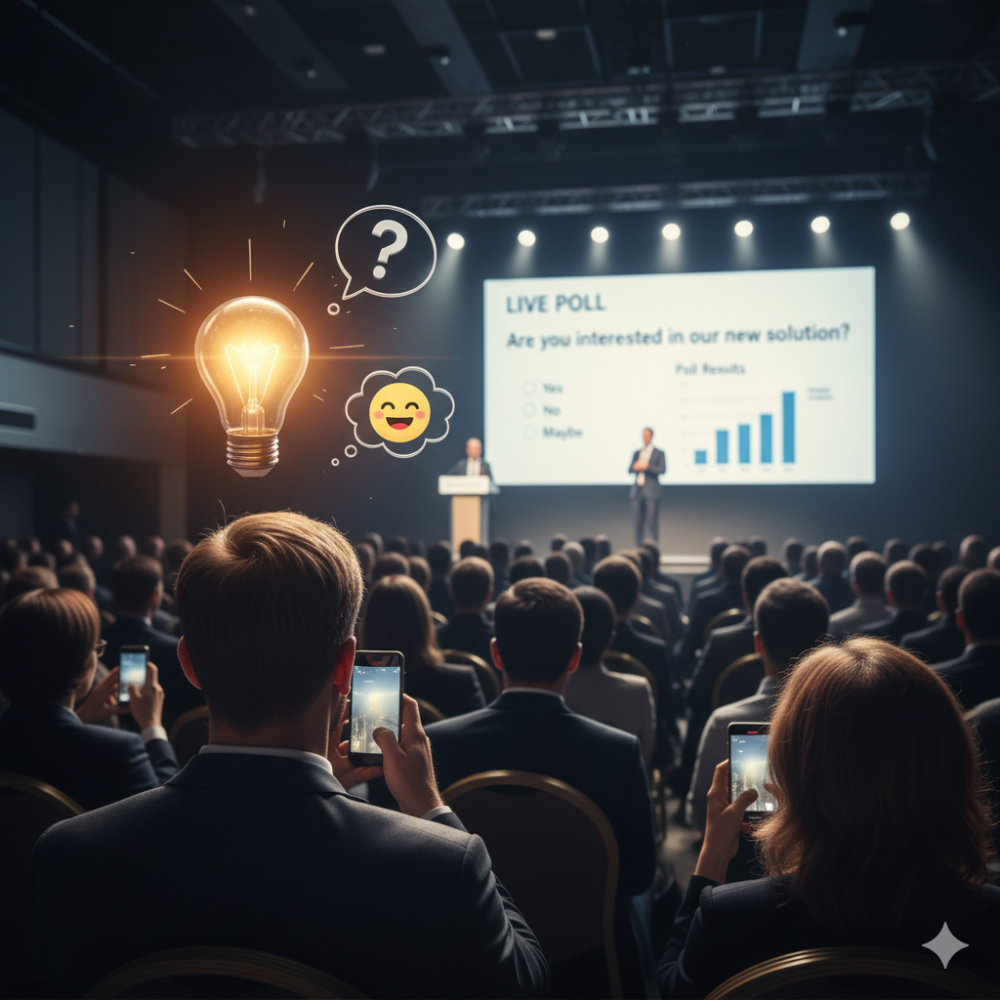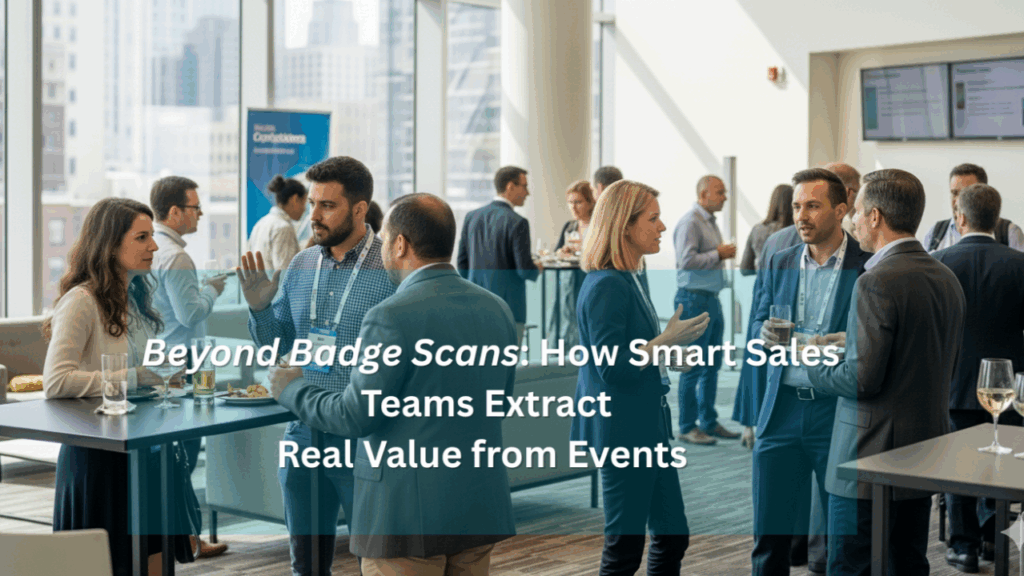Is your event playbook broken? Marketing teams often focus on attendance numbers and produce generic lead lists for sales. The real opportunity is visible just below the surface: behavioral intelligence based on buying signals.
Signal theory is standard practice in sales and marketing, and events offer the richest opportunity to capture buyer intent and convert that into pipeline and revenue.
Successful revenue teams understand that the event is a rare opportunity today to engage directly with buyers and capture what they value as they consider your offerings. That engagement can go beyond the attendee experience and provide marketing and sales with a roadmap to solving the buyer’s problem.
By consciously moving from measuring registration and attendance to capturing and transforming signals, competitive marketing teams can convert the analog experience into a complete, meaningful digital cycle.
Your best salespeople understand this intuitively. However, advances in technology bring digital signal intelligence to your entire revenue team.
Lead-Generation Thinking is a relic of dated event marketing practices.
A typical scenario is your company just spent six figures on a major industry conference. Marketing returns from the event with 500 “leads” buried in a spreadsheet full of names, titles, and email addresses from badge scans.
Sales dials through the list and experience the diminished statistical reality…most calls go nowhere. The few that connect have gone cold despite happening days after a “warm” event. Three months later, the conversion rate is even more dismal, and executives question whether events are worth the investment.
This marketing cycle is an intelligence problem, masquerading as a conversion problem.
Events Reveal Buyer Intent. Where do you look?
Every meaningful interaction at your event tells a story about buying intent. The challenge is in recognizing and capturing the signals that matter in the moment.
Consider these scenarios:
- The Executive Deep Dive: A VP of Operations bypasses general sessions to attend your technical architecture workshop, then asks detailed questions about implementation timelines. There is no capture of the questions, and the buyer disappears into the sea of competition.
- The Procurement Signal: A prospect brings their evaluation team to your booth and starts discussing key features and deployment hurdles. However, the rookie rep hosting doesn’t know how to satisfy the buyer group.
- The Expansion Play: An existing customer skips beginner content to attend advanced feature sessions and then books a time with your customer success team. When the buyer sits down, the customer success team is missing indications of what was important in the advanced feature sessions. The buyer has to inform the team.
- Competitive Intelligence: A prospect asks pointed questions comparing your solution to specific competitors—ones they’re clearly already evaluating. The data never reaches the sales team.
Each scenario represents different stages of buyer readiness. All indicate high-value opportunities, and unfortunately, they are left on the event floor since they are treated as basic leads.

Building Your Signal Intelligence System
Innovative sales organizations are redesigning their event strategy around several core principles:
1. Signal Classification Framework
The attendee experience engagement cycle plays a different role than leveraging signals that indicate buyer intent.
Establish clear rules and integrate appropriate action in your technology:
Awareness Signals: General session attendance, booth visits, and content downloads. What it means: Early-stage interest, nurture with educational content
Action: Utilize recommendation applications to enhance your understanding of your solutions.
Consideration Signals: Demo requests, pricing inquiries, and technical deep dives. What it means: Active evaluation, prioritize for sales engagement
Action: Route activity and intent signals to sales for immediate action.
Decision Signals: Executive involvement, case study and reference requests, implementation discussions. Translation: Near-term opportunity, accelerate through the pipeline.
2. Real-Time Intelligence Capture
Your event technology should work like a behavioral tracking system:
- Session Analytics: Track which sessions each attendee chooses, focusing primarily on advanced or unique content. Use the session to pose questions via polls that are designed to provoke thoughtful buyer intent.
- Engagement Depth: Measure the time spent in demos, the number of questions asked, and the frequency of follow-up materials requested. Inform sales as intent signals pass pre-established hurdle rates.
- Network Mapping: Identify when prospects bring colleagues, especially from different departments. Focus on the buyer group, not just the buyer. Capture the group at check-in and alert sales.
- Competitive Context: Capture input about alternatives, comparisons, or switching costs. Solution sessions are ideal for gathering insights into competitive intelligence.
3. Actionable Insight Delivery
Sales teams need context, in addition to contact information. Transform your raw event data into strategic intelligence:
Instead of: “Mary Smith, VP Marketing, attended your booth.” Provide via Slack: “Mary Smith attended two sessions focused on marketing automation integration, spent 15 minutes in the technical demo discussing API capabilities, and asked about customer training resources. Her colleague from IT was also present for the API discussion.”

The Revenue Impact
Organizations making this shift report dramatic improvements:
- Qualified Pipeline Acceleration: One large enterprise reported prospects identified through behavioral signals move through sales cycles up to 40% faster
- Conversion Rate Improvement: Signal-based follow-up converts 3x better than generic post-event outreach
- Resource Optimization: Sales teams focus energy on developing relationships with prospects showing genuine buying signals rather than cold-calling lead lists
Making the Transition
For Sales Leaders: Stop accepting generic lead lists. Demand behavioral intelligence that identifies prospects by intent level, not just contact information.
For Marketing Teams: Design events to create signal-generating moments. Structure sessions, demos, and interactions to reveal buyer readiness. Start with the objectives and design engagement capture to drive you toward the goal.
For Revenue Operations: Build systems that capture event signals and translate them into CRM workflows, lead scoring adjustments, and sales playbook triggers. Focus on real-time communications that pipe intelligence to the sales team at the event.
The New Event ROI Question
“How many buying signals did we identify, and how quickly can we act on them?” Let’s take that a step further. “Did we identify buying signals and take action on them during the event?”
In a world where every interaction generates data, the organizations that best interpret behavioral buying signals and act will dominate their markets.
Events reveal opportunities. Is your team equipped to see what’s really happening?
Ready to transform how your organization captures and acts on event intelligence? The shift from lead generation to signal detection is a sustainable competitive advantage.
At Certain, we bring these capabilities to life through AI-powered buying signals, engagement intelligence, and personalized session recommendations—helping marketers turn every event into a growth engine. Learn more.
[This article was first published on LinkedIn on September 3, 2025 by Peter Micciche, CEO of Certain]
